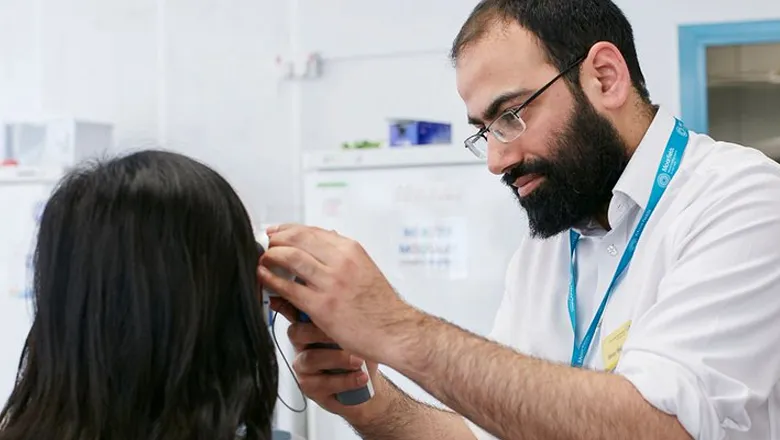King's College London researchers have shown that the brain chemical GABA regulates activity in the retina of the eye in autistic and non-autistic individuals differently. Autistic people have larger responses to single light flashes in the retina of the eye and this new study shows that increasing GABA activity can reduce this response.

Published in The Journal of Neuroscience, the study also showed that those with a greater shift in their retinal activity after receiving a single dose of the GABA drug arbaclofen were those who reported more autistic characteristics. This suggests that GABA's influence on sensory processing could be central to the more complex behaviours experienced by some people with autism.
Gamma-aminobutyric acid (GABA) is a chemical messenger in the brain that regulates the activity of nerve cells in the central nervous system. Research has indicated that there are differences in the GABA pathway between autistic and non-autistic people. Recently King's researchers used the drug arbaclofen - which switches on GABA type B receptors - to demonstrate that GABA can alter activity in areas of the brain that process visual and auditory information so that autistic and non-autistic people become more alike in their processing.
The influence of GABA on activity in the retina
Part-funded by the NIHR Maudsley Biomedical Research Centre, this new study is the first to demonstrate that using a medication which influences the GABA system can affect the activity in the retina in people with autism so that over-activity is reduced and becomes more similar to light responses in non-autistic people.
This study builds on existing research that aims to understand more precisely how GABA influences sensory processing in autism. We have found that GABA acts differently in the central nervous system in autism. At an individual level, this is related to autistic traits across both autistic and non-autistic adults in the study. We believe this means that differences in the GABA pathway could at least partly underpin autistic neurodivergence.
Grainne McAlonan, Professor of Translational Neuroscience at the Institute of Psychiatry, Psychology and Neuroscience (IoPPN), King's College London and Interim Director of the NIHR Maudsley BRC
Linking shifts in visual processing to autistic traits
This new study used hand-held devices to measure retinal responses to visual stimuli. These stimuli were single flashes of light, flickering lights or single flashes of red light. There were 61 participants, 22 with a diagnosis of autism spectrum disorder and 39 without a diagnosis. Researchers used the drug arbaclofen to modulate of levels of GABA. It was used at two different doses (15 mg and 30 mg) and there was a control group where participants received no arbaclofen.
Results showed that when exposed to single white flashes there was a larger response in the retina (a-wave activity) in people with autism than those without autism. For participants that took the drug arbaclofen there was then a decrease in the retinal activity in autistic participants but an increase in non-autistics.
Using a measure of general autistic characteristics, researchers found that the degree in which the retinal response was shifted by arbaclofen in participants was associated with autistic traits i.e. a greater shift occurred in those with more autistic characteristics both among those with autism and those without autism.
By using arbaclofen to modulate GABA we are building a clearer picture of how this brain chemical influences sensory processing at different stages. We are also gaining insight into what GABA could tell us about individual differences in autistic traits and the development of tools to predict who might benefit from an intervention option, should they wish to have that choice.
Qiyun Huang, Research Associate at IoPPN, King's College London
Professor Omar Mahroo, Professor of Retinal Neuroscience, UCL and joint senior author on the project said:
"Light detection and visual processing in the retina shapes our view of the world and this unique collaboration across traditionally distinct areas of neuroscience has helped us take a step closer to understanding that autistic people might truly see the world a little differently."
Informing future clinical trials
The study did not directly test the effectiveness of arbaclofen as an intervention for autism. Some autistic people experience sensory sensitivity which can be distressing. Whether a drug like arbaclofen might be effective in lessening visual sensitivity for people that might want this, remains to be tested. Whether the effect of arbaclofen on sensory processing might also have wider uses also needs to be examined. Importantly activity in the retina is relatively easy to measure using a hand-held device, compared to EEG which involves attaching sensors to the head to measure activity in the brain. As such the measurement of retinal activity could provide a practical way to aid the decision process as to whether individuals might benefit from participating in clinical trials of arbaclofen and other possible medical and non medical interventions, if they wish to do so.
This study exemplifies a new research strategy that researchers from IoPPN, King's College London are pioneering called the 'shiftability' paradigm. This aims to bridge the translational gap in autism research and establish who may or may not benefit from a particular intervention. It does so by directly establishing that a candidate brain chemical is involved in a brain function by changing it and observing a shift in that function. Although this experimental approach is used frequently in animal studies there is little direct evidence describing how brain chemical systems modulate information processing in the living human brain.
Retinal GABAergic alterations in adults with autism spectrum disorder (Qiyun Huang, Claire L. Ellis, Shaun M. Leo, Hester Velthuis, Andreia C. Pereira, Mihail Dimitrov, Francesca M. Ponteduro, Nichol M. L. Wong, Eileen Daly, Declan G. M. Murphy, Omar A. Mahroo, Gráinne M. McAlonan) was published in The Journal of Neuroscience.
This project was funded by an Independent Investigator Award (G.M.M.) from the Brain and Behaviour Research Foundation and by Clinical Research Associates, L.L.C. , an affiliate of the Simons Foundation. The results leading to this publication have received funding from the Innovative Medicines Initiative 2 Joint Undertaking under grant agreement No 777394 for the project AIMS-2-TRIALS. This Joint Undertaking receives support from the European Union's Horizon 2020 research and innovation programme and EFPIA and AUTISM SPEAKS, Autistica, SFARI.
Omar Mahroo received funding from the Wellcome Trust, Fight for Sight, Thomas Pocklington Trust and the NIHR BRC at Moorfields Eye Hospital and the UCL Institute of Ophthalmology.
Disclaimer: Any views expressed are those of the author(s) and not necessarily those of the funders (IHI-JU2).







